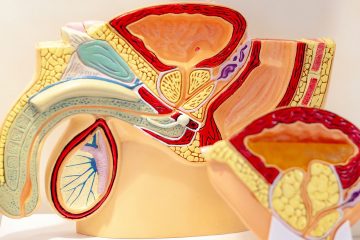Supra-pubic catheter after robotic radical prostatectomy: risks and benefits explained.
Mr Benjamin Lamb and Prof. Prabhakar Rajan
A supra-pubic catheter after robotic radical prostatectomy may be a more comfortable alternative to the traditional urethral catheter.
Anecdotally, patients can be put off choosing surgery as a treatment for prostate cancer because of fears of having a urethral catheter- a tiny plastic tube inserted into the penis to drain urine from the bladder- for up to 2 weeks after the operation whilst the join between the bladder and urethra is healing. Patients often complain that a catheter is the most uncomfortable thing about the treatment.
A potential alternative to a urethral catheter is a supra-pubic catheter. This is also a tiny plastic tube that drains urine from the bladder, but unlike a urethral catheter it passes from the bladder directly out through the skin of the tummy just above the pubic bone – hence the name “supra” (above) pubic.

The use of suprapubic catheters after robotic radical prostatectomy is often used after retzius sparing prostatectomy, where prostate is removed from under the bladder and the bladder remains in its natural position. This makes it more straightforward for the surgeon to insert, than if the bladder is moved, which occurs in standard robotic prostatectomy.
Several scientific studies have been performed to assess the risks and benefits of supra-pubic catheter after robotic prostatectomy. Below is a summary:
Benefits:
- Increased comfort: supra-pubic catheters are generally more comfortable than urethral catheters, as they avoid irritation of the sensitive urethral tissue.
- Lower infection risk: supra-pubic catheters are associated with a lower risk of urinary tract infections compared to urethral catheters.
- Easier management: For some patients with limited mobility, supra-pubic catheters may be easier to manage and care for.
- Sexual activity: supra-pubic catheters allow for sexual activity, which is difficult with a urethral catheter in place.
- Reduced urethral trauma: By avoiding catheterization through the urethra, supra-pubic catheters can prevent potential damage or irritation to the urethral tissue.
- Testing urinary control: a supra-pubic catheter can allow patients to see if they can pass urine successfully without removing the catheter.
Risks:
- Surgical complications: As supra-pubic catheter insertion requires a small incision, there are risks associated with the procedure, including bleeding, infection, or injury to surrounding organs.
- Catheter-related issues: Problems such as blockage, leakage, or accidental dislodgement can occur.
- Skin irritation: The insertion site may become irritated or infected if not properly cared for.
- Pain: Some patients may experience discomfort or pain around the insertion site, especially initially.
It’s important to note that while some studies suggest supra-pubic catheters may offer advantages over urethral catheters after robotic radical prostatectomy, the evidence is not conclusive. A review of several studies found that whilst supra-pubic catheter use was associated with decreased postoperative pain, there was also a slightly higher risk of overall complications compared to urethral catheters. Further research is needed to conclusively answer these questions, particularly with the growing popularity of retzius-sparing prostatectomy.
In summary, the decision to use a supra-pubic catheter versus a urethral catheter after prostate cancer surgery should be made on an individual basis, considering factors such as the patient’s anatomy, overall health, and personal preferences. Patients should consult with their surgeon to determine the most appropriate catheterisation method in each case.
References:
- https://www.bladderandbowel.org/surgical-treatment/suprapubic-catheter/
- https://www.healthline.com/health/suprapubic-catheter
- Bertolo R, Tracey A, Dasgupta P, Rocco B, Micali S, Bianchi G, Hampton L, Tewari AK, Porpiglia F, Autorino R. Supra-pubic versus urethral catheter after robot-assisted radical prostatectomy: systematic review of current evidence. World J Urol. 2018 Sep;36(9):1365-1372. doi: 10.1007/s00345-018-2275-x. Epub 2018 Mar 29. PMID: 29600334.
- https://www.mkuh.nhs.uk/patient-information-leaflet/what-is-a-supra-pubic-catheter
- https://my.clevelandclinic.org/health/treatments/25028-suprapubic-catheter
- https://santishealth.org/an-introduction-to-the-use-of-catheters-radical-prostatectomy/

